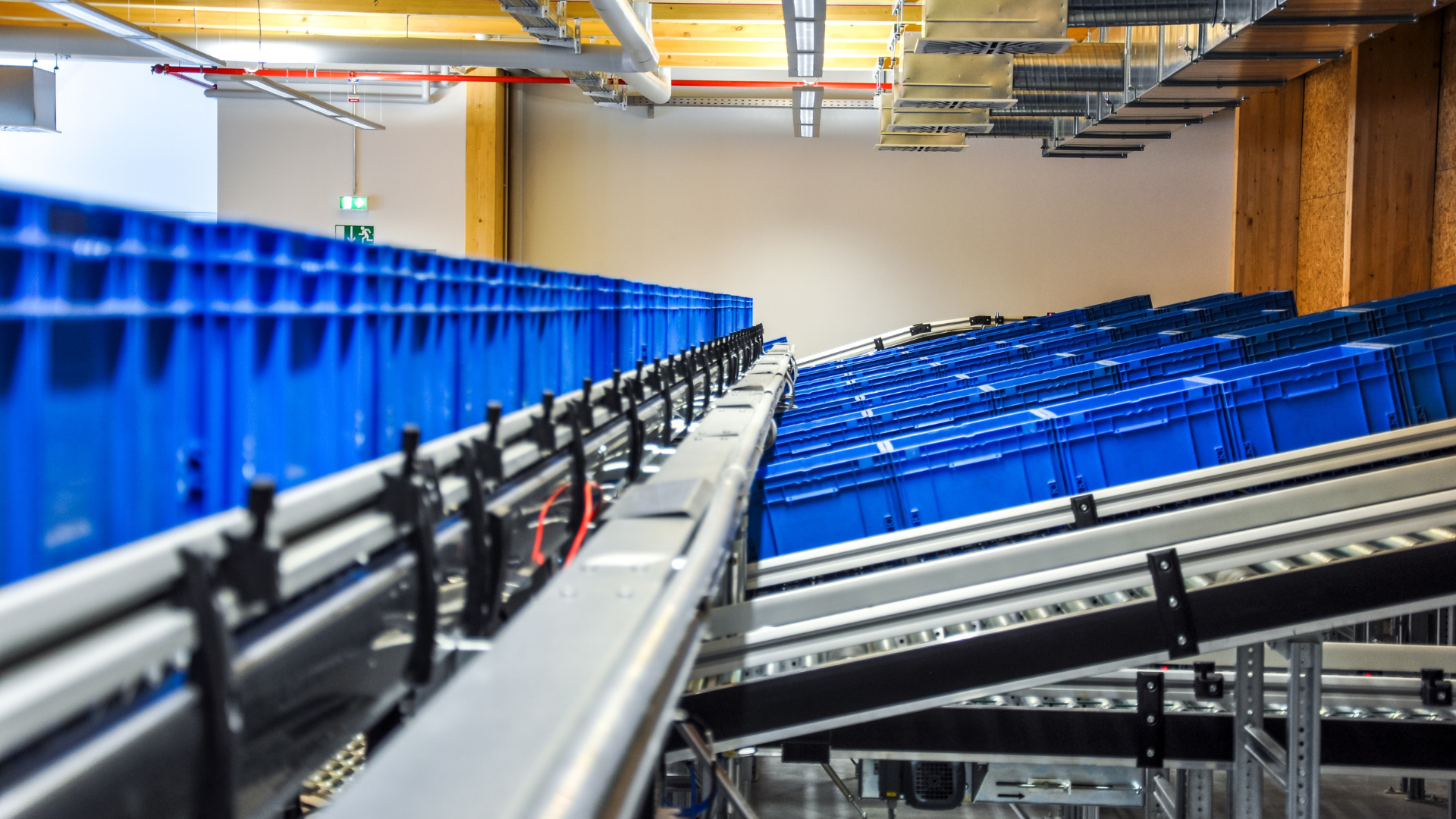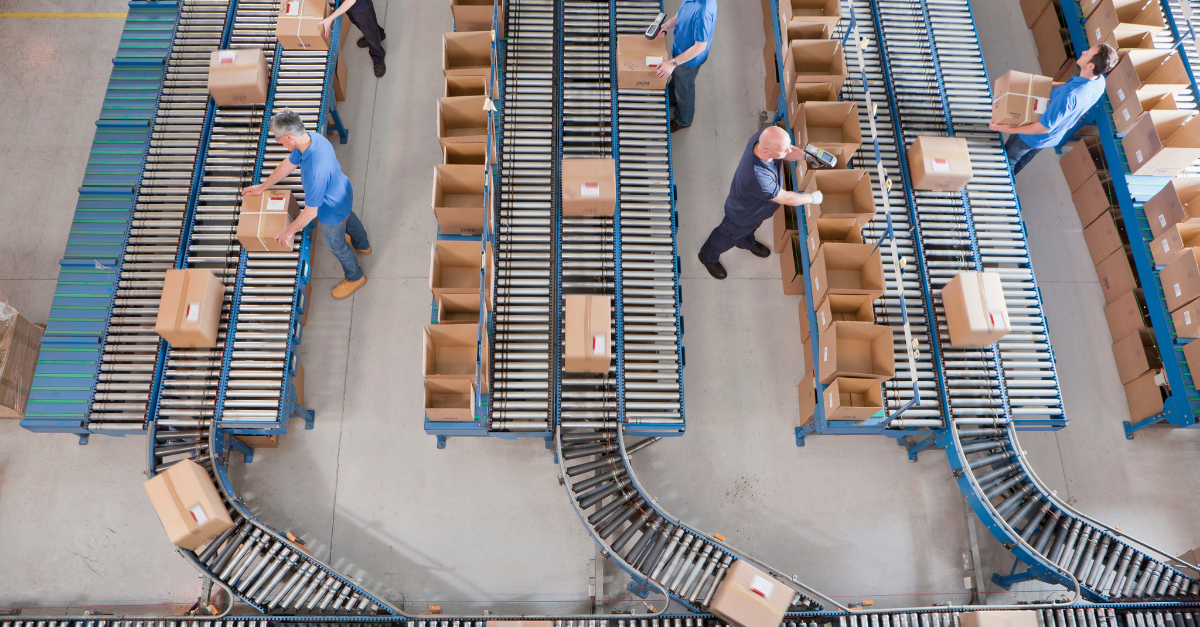 May 26, 2022
May 26, 2022  9 min to read
9 min to read Demands on today’s manufacturing businesses to operate effectively are huge. When significant competitive advantages include short and accurate delivery lead times and high product variety, margins for error are small.
A smooth material flow, from timely placed orders towards the suppliers, arrival handling, inspections, internal sourcing to the correct workstation, finished goods picking and shipment loading, is essential. To achieve this, the company must work in an organized way and minimize errors in the workflow.
Common problems in the material flow
To increase the efficiency and predictability of the material flow, having a structured and systematic way of working is vital. IT solutions for automation, an overview of the flow and follow-up is today indispensable. However, these systems could often work better if data quality and accuracy were improved.
Read more: How to integrate shop floor equipment with business systems
Manual labor still makes up a large part of the logistics work. Human error needs to be considered when humans are part of a flow. It is essential to have a well-organized physical environment and a good representation of the workflow in the IT system.
Below we summarized problems that can arise throughout the material flow, from arrival to shipment loading:
- At the Arrival: Messy arrival procedures.
– The goods might not be registered in the system directly, so we have a shortage when in reality, the material has arrived.
– The wrong part number could be registered as arrived if manually registered to a computer.
– Many goods are placed at a single location, awaiting further handling. Some goods might lay there for too long and/or might be hard to localize.
- At the Inventory: Difficulty in finding items in the inventory.
– Some inventory movements are not registered, creating a mismatch between reality and the IT system.
– Locations are too general and complex to overview.
- At the Production: Production components do not arrive fast enough at the production station.
– There is no well-working system to signal the need for re-fill and re-fill might happen when the need is spotted.
- At the Production: When consumption of production components is not registered in the system, registered late or incorrectly, re-supply will not be system generated when needed – either from main inventory or suppliers.
– Registration might happen much later if updating the IT system is down-prioritized.
– Registration might be done automatically based on theoretical consumption to save time when reporting, creating mismatches between the system and reality.
- At the Production: When tracking is essential and data of the As-Built Structure is necessary.
– Keeping track of the As-Built Structure is often challenging for producing companies where traceability is vital. The challenge is to know the used component parts (where alternatives might be used) and the serial or lot batch number in a specific production.
– In this scenario, the consumption of component individuals must be recorded with accuracy. This puts high demands for reporting on the production workers. - At the Shipment: Finished goods are not made available fast enough for picking. Allocations to orders might not be correct regarding delivery times.
- At the Shipment: Goods that should be packed for shipment might be hard to find.
Often, the way of working is not structured enough and people act in urgency. The IT system that can potentially assist needs a good setup and correct data.
What are the negative consequences of the problem?
Time is lost looking for things
Picking and/or packing the wrong items
Delayed re-fill signals when material consumption is not registered or registered late
Machine downtime due to lack of material
Cumbersome processes to keep track of the As-Built structure, sometimes including documentation kept on the side of the system.
Delivery accuracy ultimately decreased due to inefficiencies in the material flow.
More personnel is needed to keep track of the material flow when the system is messy and complicated to overview.
Why do we have these problems?
Problems firstly arise due to the workflow not being well designed and organized. It must be simple to understand and follow. Human error can be minimized in every human-to-system interaction with a well-organized workflow. Simplifying this interaction as much as possible is the key. For instance, a mix-up can easily be made when typing in data, such as article numbers.
If the logistic worker is supposed to walk over to a computer to input the information, time is lost in walking over there, but the task might even be skipped as it seems too burdensome.
How to measure the problem?
Measuring where the most significant inefficiency in the flow occurs can be the first part of figuring out where to start working with the process.
For example, one could measure the time it takes for goods to move from arrival to main inventory, the number of goods picked in an hour, and the time it took to pick and pack. With this data, guesses can be made where most errors/waste occurs in the system. However, a pre-requisite is that some input to a system is given to measure these things.
If the system is not set up well enough to collect this data, organizing the flow and ensuring that data is collected throughout is a good starting point. Once data collection is in place, more precise measurements can be conducted and analyzed to keep working with continuous improvements.
Which company types are most affected by the problem?
These issues are fundamental for any company with a supply chain. However, this post mainly focuses on the internal logistics of a producing company.
Solution proposal
A simple way to improve the efficiency and accuracy of data input is to work with handheld computers add barcode scanning, QR code scanning or RFID technology.
When goods arrive, barcode labels could be printed to identify the goods if they are not already marked. Barcode scanning can identify items and/or handle units containing several items when moving the goods. Barcode scanning is also suitable for registering material consumption in production, finished goods receiving, packing, picking and shipment loading.
The image illustrates the material flow from arrival to delivery. Possible usage of scanning is pointed out.
Barcode and QR code scanning is relatively inexpensive and straightforward, while the RFID tags and readers are more expensive but might be the best choice for some. E.g., when many items need to be scanned at once, this can be done in one go with RFID. With barcode or QR code items needs to be scanned individually. RFID can also hold much more information than the barcode or even QR code.
The overall concept of how the RFID can be used in logistics for “on the fly” materials counting
With Novacura Flow, it is easy to integrate with all the usual handheld devices. If using a mobile phone, our apps are also compatible. Novacura Flow can be run on any device that supports the latest versions of iOS, Android, or Windows. It can also be used as a web-based application in the Internet browser.
With Novacura’s low-code environment, applications are built in a custom way according to the customer’s requests. Barcode printing and scanning can be managed together with structured and straightforward interaction with other IT systems. E.g., ERP can be custom-made – without adapting the systems, we are connecting to.
In a typical situation, the user needs to go through several steps in an ERP system, perhaps searching for information from different forms and clicking through several stages. These actions can be simplified to a single input to the Novacura Flow, where the workflow can be automated.
What’s unique about this solution?
- Way simpler in implementation and more affordable than MES systems
- We’re highly integrated with ERP (think about Novacura as it was a scanner interface for your ERP), every change done in Novacura Flow immediately appears in ERP. We offer a deep integration with ERP systems (IFS Applications, Infor M3, IBM Maximo, SAP and more)
- You can implement it incrementally – if you left out requirements at the beginning, you can always implement them later after go-live due to our low-code technology. You can really achieve a continuous improvement strategy
- Novacura stands out against standardized, ready-made solutions – thanks to low-code flexibility, every element can be modified and customized
- Customers can extend the solution by themselves by access to the “source code”
Results / Benefits
What benefits do we bring to the customer by implementing our solution:
- A more effective system can reduce personnel needed, or free their time to work on other tasks
- Improve data entry efficiency and accuracy
- It gives the possibility to work with continuous improvements.
How to implement it
In Novacura we perfectly know, that all perfect and most complex solutions are worth nothing if there is no simple method to implement them! Fortunately, we have our mature and well proven implementation methodology, that helps us implement our solutions (like the one described in this article) within weeks, and not months.
We are able to provide such complex solutions in such a short time because:
- We have a library of ready-to-use industry applications, that we can reuse in new implementations,
- We use our low-code platform – Novacura Flow – that provides the ability to adjust every small element of our solution to the specific customer needs. And we can do it in a very short time since in the low-code nothing is hard-coded!
- We have already prepared connectors to the most popular ERP systems (IFS Applications, Infor M3, IBM Maximo, SAP and more)
With any implementation, it is essential to give it time and focus. Another thing is to do something in increments and not try to solve everything at once.
It is good to set up a dedicated team motivated to work on the project. It can be good to start with the low-hanging fruits, which are easy to fix and will significantly improve the process. Perhaps start with two to three apps and add on more in different phases.
To summarize
With Novacura Flow, you will get:
- Customized and straightforward solution for warehouse work
- Possibility to learn how to develop new solutions or adapt existing ones in-house
- A cost-effective way to integrate handheld devices with the ERP







